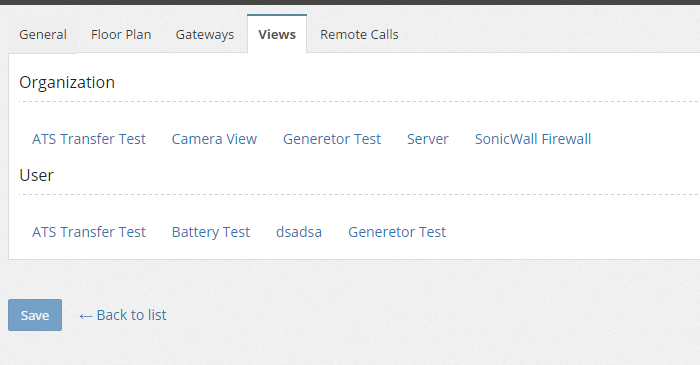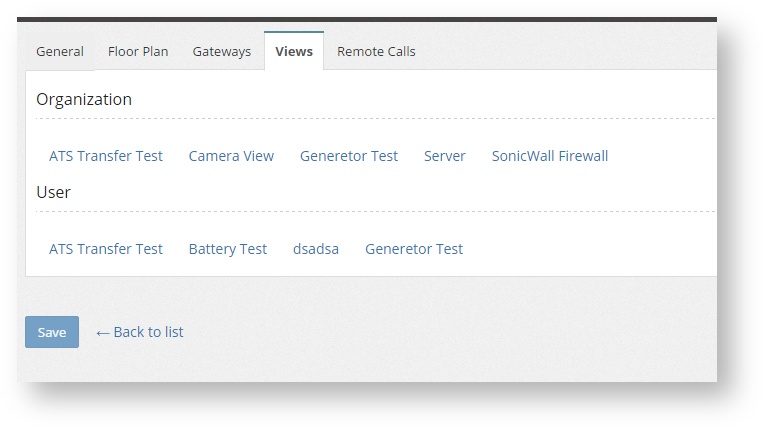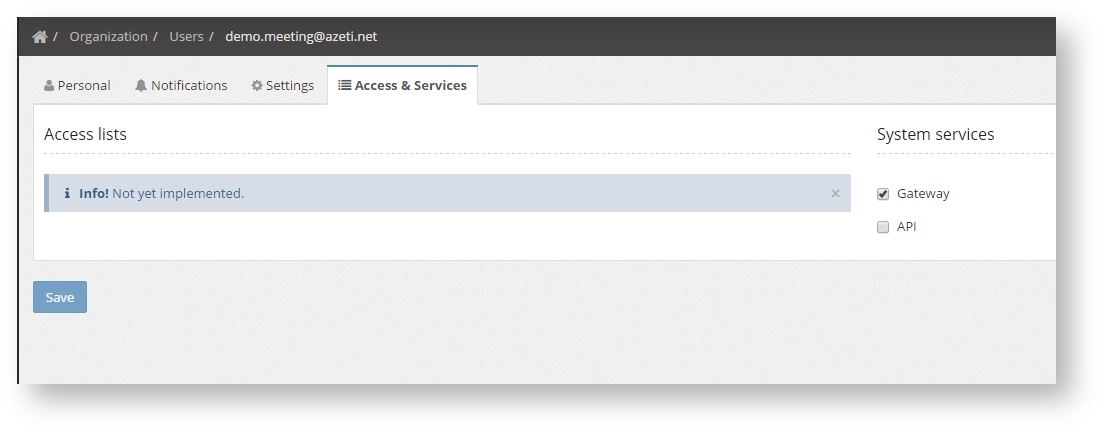| Section | ||||||||||||||||||||
|---|---|---|---|---|---|---|---|---|---|---|---|---|---|---|---|---|---|---|---|---|
|
...
- General: In this tab the following information can be changed:
- Enabled: The enabled status. If disabled the site will be hidden. It is the previous step to deletion.
- Name: The site name that will be shown on the system.
- Prod/Dev: The type of site, which can be PRODUCTIVE or TEST
- The Address, for information purpose only
- The coordinates of the site, that will be used on the dashboard map.
- The last known IP of the site is shown, but cannot be changed.
- Floor Plan: In this tab a floor plan can be selected an uploaded. It has to be an image (jpg/png)
- Gateways: In this tab is where the site template and system config template is assigned to a site. They can be selected from a drop down menu that shows all the available templates for the organization. It also shows the information about the platform used, the serial configured and the software versions.
- Views: Shows a list of all the views that can be used for this site, with a direct link to them.
- Remote Calls: If the site has any configured remote call (on the System template) it will be shown here.
| Info |
|---|
To make any change permanent always press Save before leaving the page. |
Deleting a site
To delete a site do the following:
- Go to Organization → Locations.
- Click Edit on the location to be deleted.
- Uncheck the Enabled check box.
- A Delete button will appear. Click it.
- Confirm that the site can be deleted.
| Info |
|---|
If only the Enabled checkbox is unchecked, the site will still be on the system, but it will not be shown nor it will be processing more incoming data. To show it on the locations page, just uncheck the Enabled button on the list. |
User Management
The User Management page allows the Administrator to create, delete and edit all users of the system. It can be reached in Organization → Users.
...
- Personal, where the user personal data,such as phone, name, id, etc. is set. For a new user a password has to be set. For existing users the password can be changed using the "Reset Password" option. Here the users can be deleted with the Delete button. They can also be deactivated, which means that the user will still be in the system but without being able to access the system.
- Notifications, where the user specific notifications settings are configured (see Notifications)
Settings, where the user can language can be selected, enable/disable the sounds and popup notifications, and the timeout. To disable the timeout set it to -1.
Warning Setting the timeout -1 means that the session will never be closed by the system. If a user closes it's browser and opens it again, the session will still be open and the system accessible with the last user privileges. This can be a security risk under certain scenarios.
- Access & Services, to set certain additional privileges to the users, such as Gateway (the username can be used in the gateways for connection) or API (the username can be used by third party software to access the external API)
...
Location Structure Edition
The locations tree structure shows all the locations in a predefined structure. This has to be defined by the administrator. The can be as many location trees as wanted. The user can choose which to use by selecting it:
To open the tree click the tree button left of the search box;
To create, delete and manage the Location Structure, go to Organization → Location Structure
Creating a new Location Tree
- A new tree can be added clicking the +Add button. A tree will be created will the date as name.
- Click on the name (in blue) to edit it and change it.
- Once changed click Save.
Editing the Location Tree
The Location Tree has a hierarchical structure of up to 5 levels: Country, Region 1, Region 2, City and Location. It needs to have at least two levels: The Location and an upper lever.
To add the upper levels, click +Add Structure Element. It will show all the options:
A new level can also be created using the + button on an existing element. The new one will be placed under it if it is of a lower level. The new element can be then edited. The name will be empty, but can be changed just by clicking on it.
For each element the following can be done:
- Move the item around using Drag And Drop, dragging from the left end of the item
- Expand or Contract the lower levels
- Select the country flag (only for countries). Use the two letter country code (ISO 3166-1 alpha-2). After putting the two letter code and saving the proper flag will be shown.
- Change the item name. Can be edited by clicking on it.
- Change the element level.
- Add a new element.
- Delete the current element
Once the upper levels are in place, the locations can be placed in under the right element. To do that just drag and drop the location to the correct place. Drag by the symbol at the left end of the location.
| Warning |
|---|
Remember to click the Save button before leaving the page to make all changes permanent. |
External API
In this page is the external API to connect to third party software is enabled. Just select the parts of the API that need to be enabled. They will be activated immediately and the options saved.
For more details on the External API go to External API
General Settings
Organization → Settings shows the general settings of the organization.
It includes:
- Organization name and short name. They cannot be changed. The Oganization Short Name has to be used on the SiteController for correct configuration.
- Map Widgets: This option lets the Administrator select the type of marker of the dashboard map. There are two types:
- Map Marker →
- BTS Antenna →
- Logo: A image can be uploaded and will be shown as a logo on the top left corner of the screen.
- Generator Test: Here a json can be pasted to create new items on the Operations menu. See next section on how to configure them.
Creating New Operations Items
To create new items on the operations menu a json with the desired item has to be pasted on the Generator Test section of the Organization Settings. This items allow the user to perform and action on all the sites (or they sites of his choosing) at the same time and from the same screen. This is as example of a json:
| Code Block | ||
|---|---|---|
| ||
[{
"name": "Switch Sites to Generator",
"startAction": {
"actionId": "Switch_Power",
"commandStart": "GENERATOR",
"commandCancel": "GRID"
},
"resultSensors": [
"Switch_Power"
],
"readyStates": {
"sensorId": "Switch_Power",
"states": [
"SITE ON GENSET - AUTO",
"SITE ON GRID - AUTO",
"SITE ON BATTERIES - AUTO"
]
}
},
{
"name": "Switch Sites to Grid",
"startAction": {
"actionId": "Switch_Power",
"commandStart": "GRID",
"commandCancel": "GENERATOR"
},
"resultSensors": [
"Switch_Power"
],
"readyStates": {
"sensorId": "Switch_Power",
"states": [
"SITE ON GENSET - MANUAL"
]
}
}] |
This json defines two items. Each one has the following fields:
name: The item name that will be shown on the Operations menu
startAction: Defines the action that can be triggered in this item:
actionId: The name of the action, as defined on the site template.
commandStart: The command that will be triggered as a start.
- commandCancel: The command triggered if the action has to be canceled
- resultSensors: The name of the sensor that will be shown on the result list. Has to be the same name for all the sites. The result list will display sensor for each site that has it configured.
- readyStates: This will indicate which sensor and state to check before triggering the actions. This means that unless this sensor is in the specified state the action cannot be started.
- sensorId: The name of the sensor that will indicate the action can be performed.
- states: The state the sensor has to be in.
































